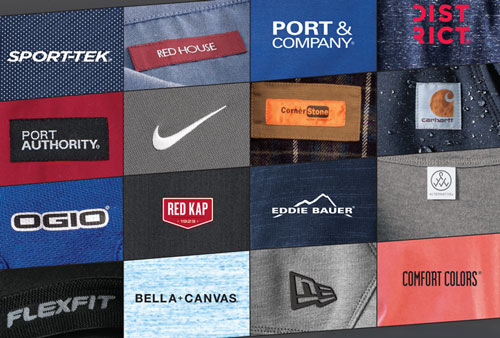Branded Clothing Essentials: Understanding the Fabric Behind the Fashion
Recognizing Apparel: The Relevance of Material Choices in Your Closet
The choice of fabric in apparel plays an essential role in both looks and performance. Different products offer varying levels of breathability, sturdiness, and convenience, directly affecting the user's experience. Recognizing these nuances can boost one's wardrobe significantly. Yet, lots of overlook how these options can influence not simply personal style, but likewise sustainability. What textile choices could redefine your closet and straighten it with both style and duty?
The Function of Fabric in vogue and Capability

Typical Fabric Kinds and Their Qualities
When picking apparel, recognizing the features of typical fabric kinds is crucial for making informed choices. Cotton, a widely-used all-natural fiber, is recognized for its adaptability, breathability, and softness, making it appropriate for sportswear and everyday garments. Bed linen, an additional natural option, boasts outstanding moisture-wicking residential properties and a distinct appearance, ideal for warm climates.Wool, frequently preferred for its warmth and longevity, differs in fineness; merino woollen is soft versus the skin, while coarser types are used for outerwear. Synthetic materials like polyester and nylon offer resilience and resistance to wrinkles, making them prominent for activewear and travel garments. Finally, blends, which integrate natural and artificial fibers, can improve performance while maintaining convenience. By identifying these fabric qualities, people can select garments that straightens with their lifestyle and visual preferences.
Breathability and Comfort: Choosing the Right Fabrics for Different Environments
Choosing the best materials for various environments can significantly enhance convenience and overall wearability. Breathable products are essential in hot climates, as they enable air circulation and dampness dissipation. Fabrics such as cotton, linen, and moisture-wicking synthetics efficiently draw sweat away from the body, maintaining the user cool and dry. On the other hand, in colder climates, thicker materials like wool or fleece offer insulation while retaining breathability, ensuring warmth without overheating.Additionally, the option of material weight plays a vital function; light-weight materials are more effective for summer season, whereas heavier alternatives are suited for winter wear. Comprehending the special buildings of each material makes it possible for individuals to clothe appropriately for differing weather conditions. Inevitably, picking breathable and comfortable materials tailored to particular climates can considerably boost everyday convenience and enhance the general experience of using clothes.
Sturdiness and Treatment: Just How Textile Impacts Durability of Your Wardrobe
Selecting the best materials can greatly impact the sturdiness and treatment demands of a closet. Fabrics such as cotton and polyester are understood for their durability and convenience of maintenance, making them perfect for daily wear. In contrast, fragile products like silk and shoelace call for even more cautious handling and specialized cleansing methods, which can increase the moment and effort required for care. Branded Clothing.Durability is likewise affected by the fabric's weave and coating; firmly woven fabrics often tend to withstand wear and tear much better than loosely woven choices. In addition, artificial blends typically give enhanced longevity, combining the very best top qualities of several fibers.Understanding the get more care instructions for every fabric is essential, as inappropriate washing or drying can bring about early wear. Ultimately, selecting resilient materials can cause a longer-lasting closet, lowering the regularity of replacements and adding to an extra lasting style option
The Effect of Material on Fit and Shape

Lasting Fabric Selections: Making Eco-Friendly Choices
The effect of textile expands past fit and shape to incorporate ecological aspects, prompting a growing rate of interest in lasting textile options. Green materials, such as organic cotton, hemp, and Tencel, are getting traction amongst customers that focus on sustainability in their closets. These products are usually created with fewer chemicals and water, reducing their environmental footprint.Additionally, recycled textiles, made from post-consumer waste, offer an ingenious option to the fabric industry's pollution trouble. Brands increasingly embrace transparency in their sourcing methods, permitting customers to make educated decisions about their purchases.Choosing sustainable materials not only supports ethical techniques yet likewise motivates the style sector to embrace more liable production approaches. As awareness of environmental problems climbs, individuals are prompted to assess the lasting impact of their fabric options, promoting a movement in the direction of an extra lasting and eco mindful technique to style.
Elevating Design: Exactly How Material Can Change a Clothing
While several may concentrate on shade and cut when selecting an outfit, the option of material plays an essential function in elevating design and enhancing general look. Different materials convey unique moods and messages; for instance, silk emanates deluxe and refinement, while denim provides a casual, unwinded ambiance. The appearance and discover this drape of a fabric can substantially change the shape, with structured textiles offering a refined look and softer ones developing a more fluid, unwinded aesthetic.Moreover, the weight of the fabric influences wearability throughout seasons. Lightweight materials like bed linen and cotton are excellent for summertime, while larger products such as woollen and velvet supply warmth and sophistication in cooler months. Understanding textile residential or commercial properties, such as breathability and stretch, also encourages people to make educated selections that boost comfort without endangering style. Ultimately, the ideal fabric can transform a clothing from average to remarkable, making it a crucial factor to consider in any kind of closet.
Regularly Asked Questions
Exactly how Do I Determine the Fabric Web Content of My Clothing?
To identify fabric content, one can check out care tags, conduct melt examinations for fiber identification, or consult material examples. These techniques aid distinguish materials, making sure educated selections for apparel care and maintenance in daily wear.
Can Textile Choice Affect My Mood or Self-confidence?
Textile choice can substantially influence a person's state of mind and confidence. Branded Clothing. Specific materials may evoke feelings of comfort or beauty, while others can feel limiting or unflattering, inevitably affecting self-perception and psychological health throughout the day
What Fabrics Are Best for Sensitive Skin?
For individuals with sensitive skin, all-natural materials like bamboo, cotton, and bed linen are frequently recommended. These products are breathable, hypoallergenic, and much less most likely to trigger irritation, making them appropriate choices for convenience and skin health.
Just how Do I Correctly Laundry and Take Care Of Different Fabrics?
To properly wash and care for different materials, one need to take into consideration each product's details requirements, consisting of temperature settings, cleaning agents, and drying methods, making certain longevity and maintaining the fabric's original qualities for suitable use.
Are There Particular Fabrics for Athletic or Efficiency Wear?
Sports or efficiency wear typically makes use of fabrics such as polyester, nylon, and spandex. These materials are designed for moisture-wicking, breathability, and adaptability, enhancing activity and comfort throughout physical activities while giving durability and support. Alternatively, in colder climates, thicker fabrics like wool or fleece give more insulation while retaining breathability, ensuring warmth without overheating.Additionally, the option of textile weight plays an important function; light-weight fabrics are better for summer season, whereas heavier choices are matched for winter wear. In contrast, fragile materials like silk and lace need even more careful handling and specialized cleaning techniques, which can increase the time and initiative required for care.Durability is likewise influenced by the textile's weave and coating; securely woven materials tend to withstand wear and tear much better than loosely woven options. In contrast, stiff fabrics can limit motion yet give a timeless, refined look.Moreover, the density and appearance of the fabric can influence the aesthetic understanding of body form. The influence of fabric prolongs beyond fit and silhouette to incorporate ecological aspects, prompting an expanding rate of interest in sustainable textile options. The structure and drape of a textile can dramatically alter the silhouette, with structured materials providing a refined look and softer ones creating a much more fluid, loosened up aesthetic.Moreover, the weight of the textile influences wearability across seasons.